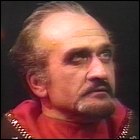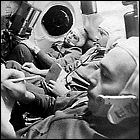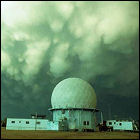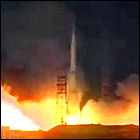Out Of The Unknown: The Last Witness
 BBC2 airs the 45th episode of science fiction anthology series Out Of The Unknown. Written by Martin Worth, the story stars Anthony Bate. This episode no longer exists in the BBC’s archives.
BBC2 airs the 45th episode of science fiction anthology series Out Of The Unknown. Written by Martin Worth, the story stars Anthony Bate. This episode no longer exists in the BBC’s archives.
 BBC2 airs the 45th episode of science fiction anthology series Out Of The Unknown. Written by Martin Worth, the story stars Anthony Bate. This episode no longer exists in the BBC’s archives.
BBC2 airs the 45th episode of science fiction anthology series Out Of The Unknown. Written by Martin Worth, the story stars Anthony Bate. This episode no longer exists in the BBC’s archives.
 The 301st episode of Doctor Who airs on BBC1. Roger Delgado and Damaris Hayman guest star.
The 301st episode of Doctor Who airs on BBC1. Roger Delgado and Damaris Hayman guest star.
More about Doctor Who in the LogBook
Order VWORP!1 from theLogBook.com Store
 After a tuberculosis scare forces Soviet space officials to ground the mission’s original crew, the backup crew of Soyuz 11 lifts off to become the first occupants of a manned space station. Experiencing none of the difficulties that plagued the earlier Soyuz 10 attempt to dock with Salyut 1, the Soyuz 11 crew stays aboard Salyut for 22 days, a new record for a manned space mission.
After a tuberculosis scare forces Soviet space officials to ground the mission’s original crew, the backup crew of Soyuz 11 lifts off to become the first occupants of a manned space station. Experiencing none of the difficulties that plagued the earlier Soyuz 10 attempt to dock with Salyut 1, the Soyuz 11 crew stays aboard Salyut for 22 days, a new record for a manned space mission.
 The National Severe Storms Laboratory‘s 10cm Doppler weather radar begins full-time experimental operation in Norman, Oklahoma, just in time for the region’s active severe weather season. A surplus Air Force radar left over from the Distant Early Warning radar network (also known as the DEW Line) is installed and housed in a facility that’s also made of military surplus parts. There is no real-time display at first: researchers and meteorologists store the Doppler radar’s observations on computer tape that has to be processed and printed months after the fact, and compared to archived records from the existing WSR-57 radar at Norman.
The National Severe Storms Laboratory‘s 10cm Doppler weather radar begins full-time experimental operation in Norman, Oklahoma, just in time for the region’s active severe weather season. A surplus Air Force radar left over from the Distant Early Warning radar network (also known as the DEW Line) is installed and housed in a facility that’s also made of military surplus parts. There is no real-time display at first: researchers and meteorologists store the Doppler radar’s observations on computer tape that has to be processed and printed months after the fact, and compared to archived records from the existing WSR-57 radar at Norman.
 The 302nd episode of Doctor Who airs on BBC1. Roger Delgado and Damaris Hayman guest star.
The 302nd episode of Doctor Who airs on BBC1. Roger Delgado and Damaris Hayman guest star.
More about Doctor Who in the LogBook
Order VWORP!1 from theLogBook.com Store
 BBC2 airs the 47th episode of science fiction anthology series Out Of The Unknown. Written by Quatermass creator Nigel Kneale, the story stars Patrick Troughton (Doctor Who). This episode no longer exists in the BBC’s archives.
BBC2 airs the 47th episode of science fiction anthology series Out Of The Unknown. Written by Quatermass creator Nigel Kneale, the story stars Patrick Troughton (Doctor Who). This episode no longer exists in the BBC’s archives.
 The 303rd episode of Doctor Who airs on BBC1. Roger Delgado and Damaris Hayman guest star. This episode wraps up the eighth season.
The 303rd episode of Doctor Who airs on BBC1. Roger Delgado and Damaris Hayman guest star. This episode wraps up the eighth season.
More about Doctor Who in the LogBook
Order VWORP!1 from theLogBook.com Store
 BBC2 airs the 48th episode of science fiction anthology series Out Of The Unknown. Written by Michael J. Bird, the story stars John Nettleton and June Ellis. This episode no longer exists in the BBC’s archives.
BBC2 airs the 48th episode of science fiction anthology series Out Of The Unknown. Written by Michael J. Bird, the story stars John Nettleton and June Ellis. This episode no longer exists in the BBC’s archives.
 Though the race to the moon has already been lost, the Soviet space program continues to refine its giant N1 rocket, conducting extensive modifications to nearly all of its systems. The third N1 to lift off almost immediately loses directional control, forcing ground controllers to signal it to self-destruct less than a mile off the ground. Its cargo is an unmanned Soyuz/Korabl combo – the Soviet answer to the Apollo command/service module and landing module – though this time there is no launch escape system, so the vehicle is destroyed along with its booster.
Though the race to the moon has already been lost, the Soviet space program continues to refine its giant N1 rocket, conducting extensive modifications to nearly all of its systems. The third N1 to lift off almost immediately loses directional control, forcing ground controllers to signal it to self-destruct less than a mile off the ground. Its cargo is an unmanned Soyuz/Korabl combo – the Soviet answer to the Apollo command/service module and landing module – though this time there is no launch escape system, so the vehicle is destroyed along with its booster.
 After a record-setting 22 day stay about Soviet space station Salyut 1, the crew of Soyuz 11 prepares to return home. As they undock and fire their retro rockets to bring their vehicle out of orbit, Soyuz depressurizes without warning, killing the crew – Georgi Dobrovolski, Vladislav Volkov and Viktor Patsayev – within a minute. (The cramped design of the Soyuz cabin makes no allowances for cosmonauts to wear spacesuits.) Soyuz flights will be grounded for two years until the vehicle can be redesigned to prevent another tragedy. Two members of the grounded prime crew, Alexei Leonov (the first man to walk in space) and Valery Kubasov, are later reassigned to the international Apollo-Soyuz mission in 1975.
After a record-setting 22 day stay about Soviet space station Salyut 1, the crew of Soyuz 11 prepares to return home. As they undock and fire their retro rockets to bring their vehicle out of orbit, Soyuz depressurizes without warning, killing the crew – Georgi Dobrovolski, Vladislav Volkov and Viktor Patsayev – within a minute. (The cramped design of the Soyuz cabin makes no allowances for cosmonauts to wear spacesuits.) Soyuz flights will be grounded for two years until the vehicle can be redesigned to prevent another tragedy. Two members of the grounded prime crew, Alexei Leonov (the first man to walk in space) and Valery Kubasov, are later reassigned to the international Apollo-Soyuz mission in 1975.
 BBC2 airs the 49th and final episode of science fiction anthology series Out Of The Unknown. Written by David T. Chantler, the story stars Freddie Jones (Children Of The Stones, Dune). This final episode no longer exists in the BBC’s archives.
BBC2 airs the 49th and final episode of science fiction anthology series Out Of The Unknown. Written by David T. Chantler, the story stars Freddie Jones (Children Of The Stones, Dune). This final episode no longer exists in the BBC’s archives.